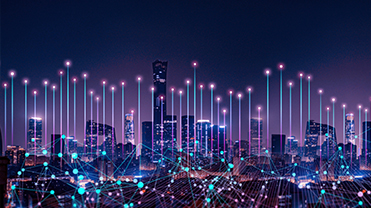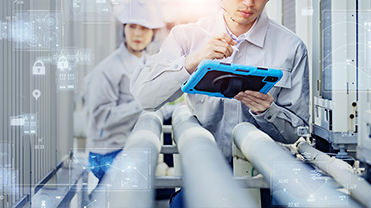Lighting the way for
smarter buildings
Interconnected lighting systems can transform a built environment into a sustainable space that meets net-zero objectives and building operational goals. These systems convert a building into a network of smart devices, improving energy conservation, operational efficiency, occupant comfort, safety, and security. They use sensors, LEDs, wireless networks, and building automation software to make automatic energy adjustments and optimise natural daylight. Smart lighting systems can collaborate with the BAS, increasing operational efficiency and creating a highly comfortable and healthy environment for occupants. They can also be used to enhance building security and make retail spaces smarter. The global market for smart lighting is anticipated to reach almost USD $46.90 billion by 2028, indicating a growing trend towards this technology.
What makes a lighting system 'smart'?
Is it their ability to ‘see’ and ‘hear’ commands? Or, their ability to communicate with multiple devices within a building’s ecosystem to make intelligent decisions about factors like brightness levels, ambient temperature, and lighting control, ultimately maximizing energy efficiency?
These features, and more, make smart lighting a sought-after commodity in intelligent buildings, providing immeasurable benefits to owners and operators.
And the world seems to agree too; a global market research firm estimated that by 2028, the global market for smart lighting would increase to a value of almost USD $46.90 billion. This rising trend is here to stay, whether it’s due to energy efficiency, operational cost reduction, or for the increased Internet of Things (IoT) adoption and ubiquity.
Smart lights in buildings: how they make spaces more intelligent
Interconnected lighting systems possess the ability to transform a building into a giant linked network of smart devices, all working seamlessly to meet building objectives and turn the built environment into a productive, sustainable, and net-zero green building. As for how they do it, read on to find out.
Energy conservation
Buildings are a black hole in the universe of energy consumption, responsible for depleting around 30% of energy worldwide. And of all the systems that help a building function seamlessly, one of the most essential is the lighting system which is responsible for significant amounts of energy consumption. But with the complexity and the sheer number of lighting systems needed in each building, controlling lighting levels in an energy-efficient way becomes very difficult. That is where smart technology steps in, providing IoT the foundation it needs to save tomorrow’s buildings’ precious energy while slashing costs. Intelligent lighting systems — which combine sensors, LEDs, and wireless networks with building automation software — can make automatic energy adjustments, using sensor-based data on the room’s temperature, humidity, and carbon monoxide levels to gauge the number of occupants and adjust lighting parameters as needed. Daylight harvesting techniques automatically dim or adjust the brightness in response to the amount of natural light available in a space, thus optimally utilising natural daylight. Further, smart lights can be integrated with window shade control systems to utilise natural lights for optimal energy efficiency.
Energy saving is taken a step further by the Automated Demand Response (ADR), which is a way for companies to reduce energy usage to manage high demand. During periods of high energy usage, like summers or cold nights, utility companies send signals to energy-using devices to conserve energy by changing indoor temperatures, dimming lights, and more. Smart lights play a big role here, performing automatic dimming, daylight harvesting, scheduling, maintaining the circadian rhythm, and other related functions to best manage light levels. California’s Title 24 energy code, among many other green building standards, covers demand response in every release.
Operational efficiency
A building management system (BMS) without integrated smart lighting functions at lower efficiency. When smart lighting systems interoperate with the BAS, synergies are created among lighting and HVAC systems, ensuring the highest operational efficiency possible.
Building owners and facility managers are already using smart lighting to improve the way they function. For instance, a Softdel customer is using a power over Ethernet (PoE)-enabled intelligent lighting solution that interconnects commercial spaces like modern workplaces, educational institutions, and healthcare facilities, and most importantly, reduces operational and energy costs for their legacy IT solutions.
In another use case, during the pandemic, a smart lighting system enabled contact tracing by sending alerts to people who had came in contact with a Covid-infected person within the building. Another use case is using smart lighting to send alerts to janitorial services to clean specific areas, saving costs and improving operations.
Occupant comfort
The recent global emphasis on protecting human health and well-being has turned the conversation toward intelligent lights and their ability to increase occupant comfort. A smart building with human-centric lighting systems is capable of revolutionising the building industry. For instance, circadian lighting, which mimics the daylight spectrum, is used to regulate lighting levels and brightness for optimum comfort. Lighting controls can customise colour and light temperature to create a highly comfortable and healthy environment for the occupants. These systems can also easily be integrated with smart home devices like Alexa or Google Nest, providing an additional layer of control.
The BACnet protocol now inherently supports those lighting-centric objects that provide very specific control over functions like dimming, colour temperature, and lux levels? This has led to dynamic environments which not only promote energy saving but also boost productivity.
Want more information about BACnet and how it influences digital transformation the world of smart buildings?

please share details
for download
Safety and security
In addition to providing illumination, comfort, and operational excellence — lighting also plays a major role in occupant safety. Motion sensors can light up entryways, corridors, and underground garages. Window blinds can now simultaneously talk to smart lights and heating, ventilation, and air conditioning (HVAC) systems to maintain a room’s temperature and its ambient light. A building’s safety protocols can be significantly enhanced when elevators, lighting systems, and fire alarm systems learn to ‘talk’ to each other. For example, during emergencies, lighting can guide evacuees to the closest evacuation route. Smart lights also enable heightened building security – unexpected motion or occupancy detection can trigger lights, set off an alarm, and send a mobile alert to concerned authorities when someone enters restricted spaces or rooms.
Making retail smarter
Smart apps, linked to ceiling lights, can direct customers towards their preferred products around the store. Smart lights can be used to monitor and record food storage sections in stores, sending alerts to the management when food is near its expiration date, thus reducing spoilage. Valuable products and other assets can also be ‘tagged’ with special sensors, enabling IoT-led lighting to continuously track them based on their signals, enhancing their security.
Making intelligent buildings a reality with smart lighting
Efficient, environment-friendly, and cost-effective — smart lighting has emerged as a crucial component to revolutionise buildings and their infrastructure. The world is now a well-connected hub of interlinked devices and IoT smart buildings; prime examples of such smart-enabled lighting solutions that show us how the buildings of tomorrow will look like include the Edge in Amsterdam, the Hindmarsh Shire Council Corporate Centre in Australia, and the Crystal in London, all designed to focus on sustainability and creating greener structures.
Energy usage is growing, and will continue to grow; research by the International Energy Agency shows energy demands in built environments will go up by 50% in 2050, something our already embattled planet cannot handle. Switching to smart lighting is one of the major defences we have in building a greener, more efficient building ecosystem, one that reduces the energy demand and enhances occupants’ quality of life.
Learn how Softdel supports these buildings of the future with comprehensive IoT-led digital solutions, including 60+ digital lighting solutions : https://www.softdel.com/digital-building-solutions/






